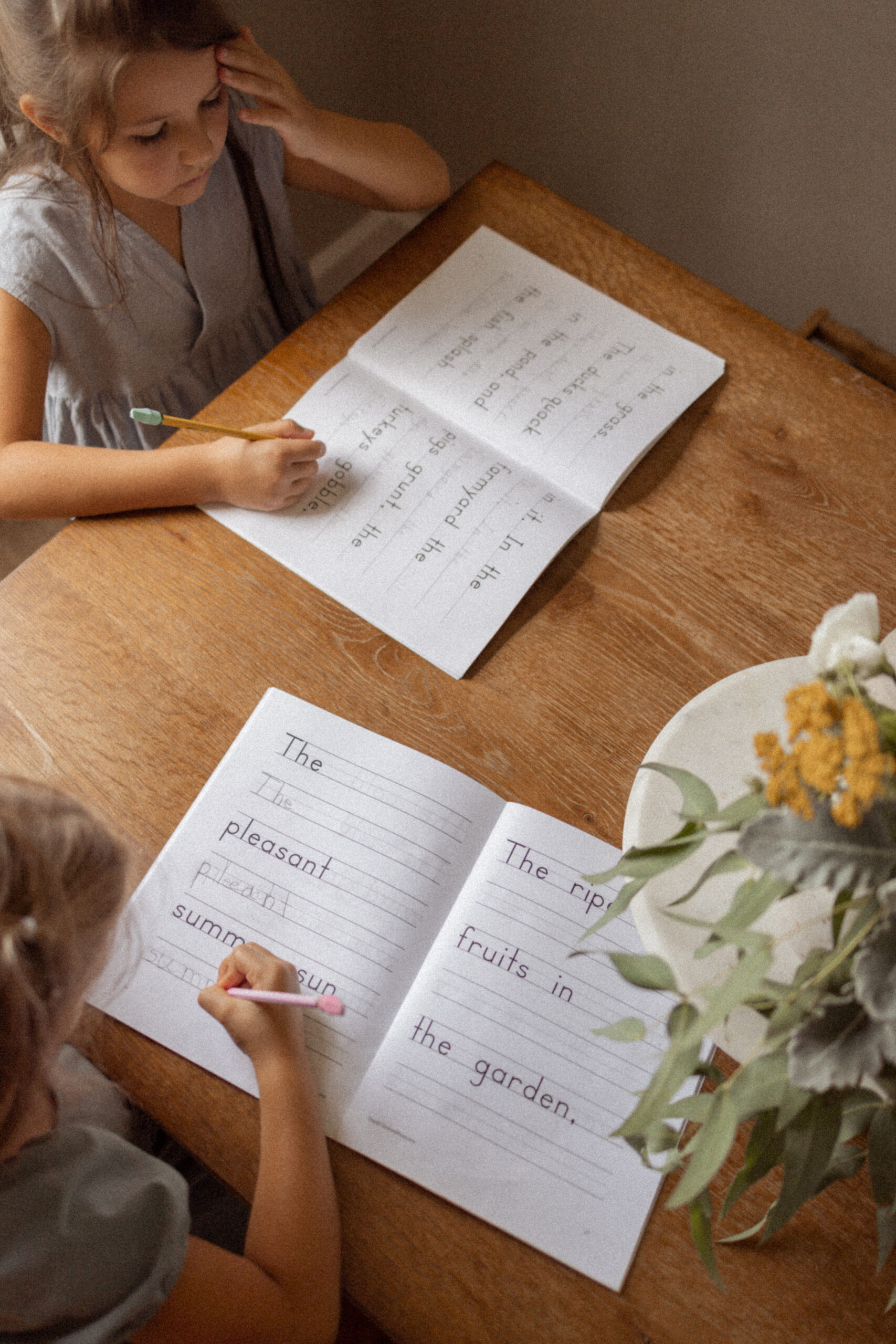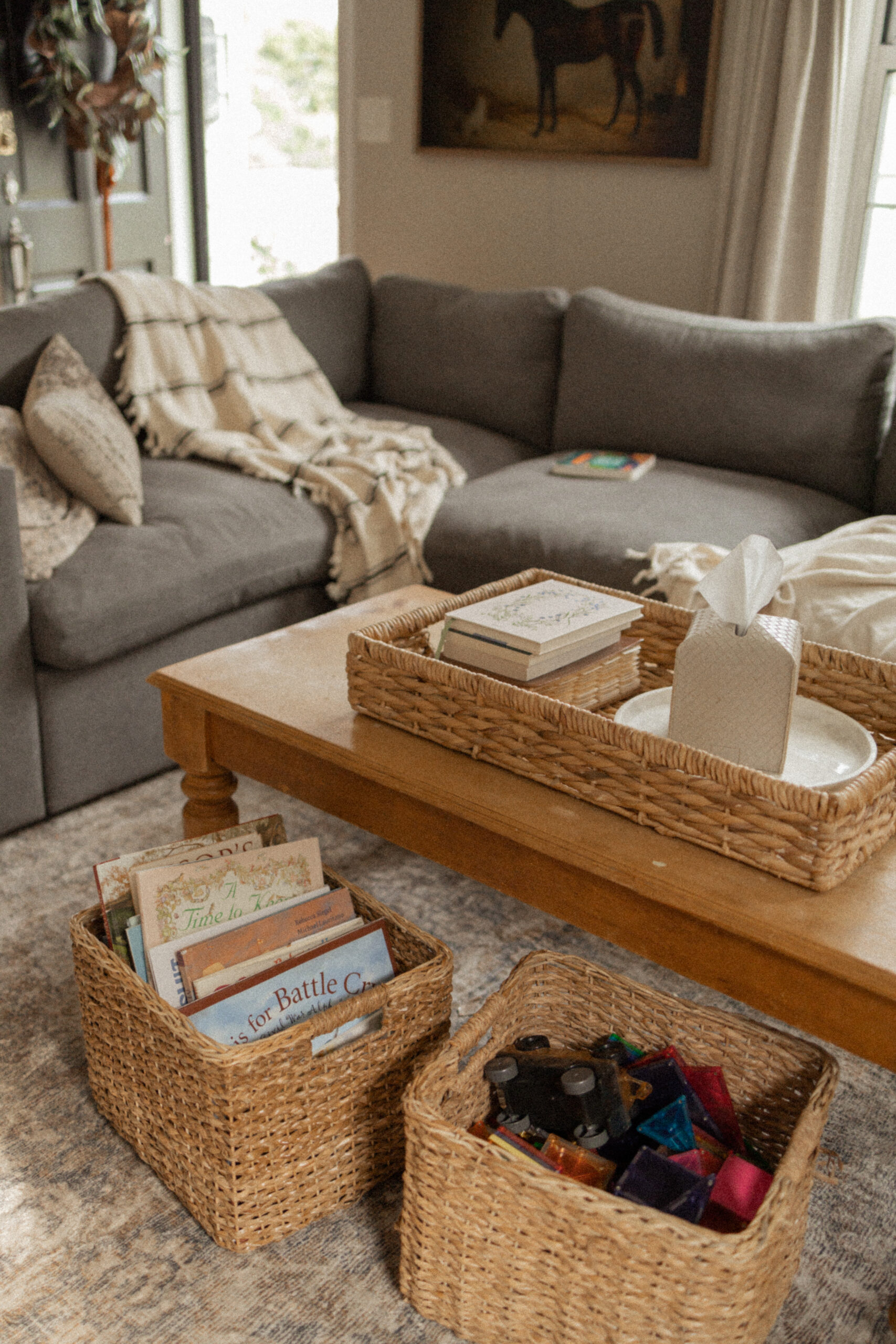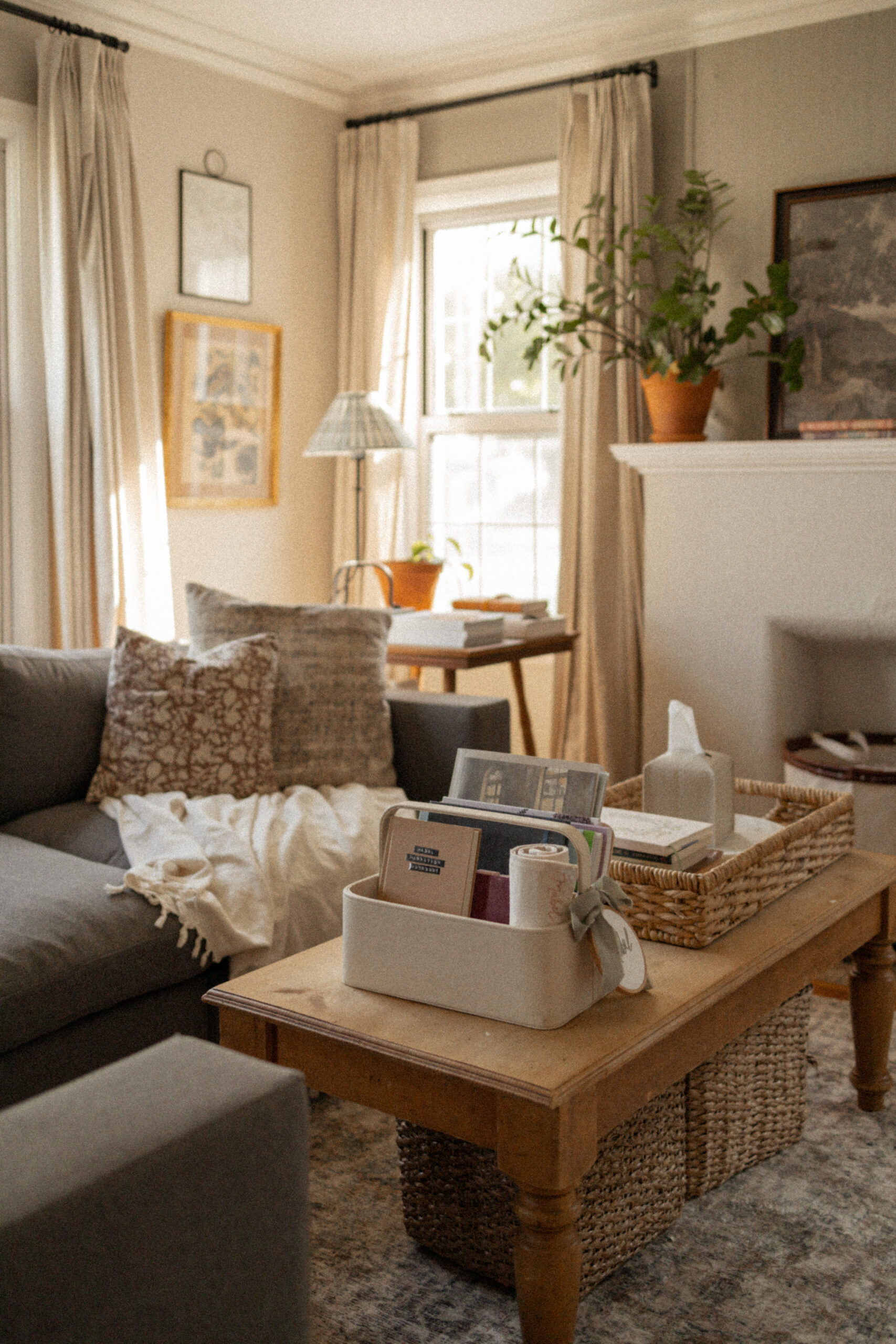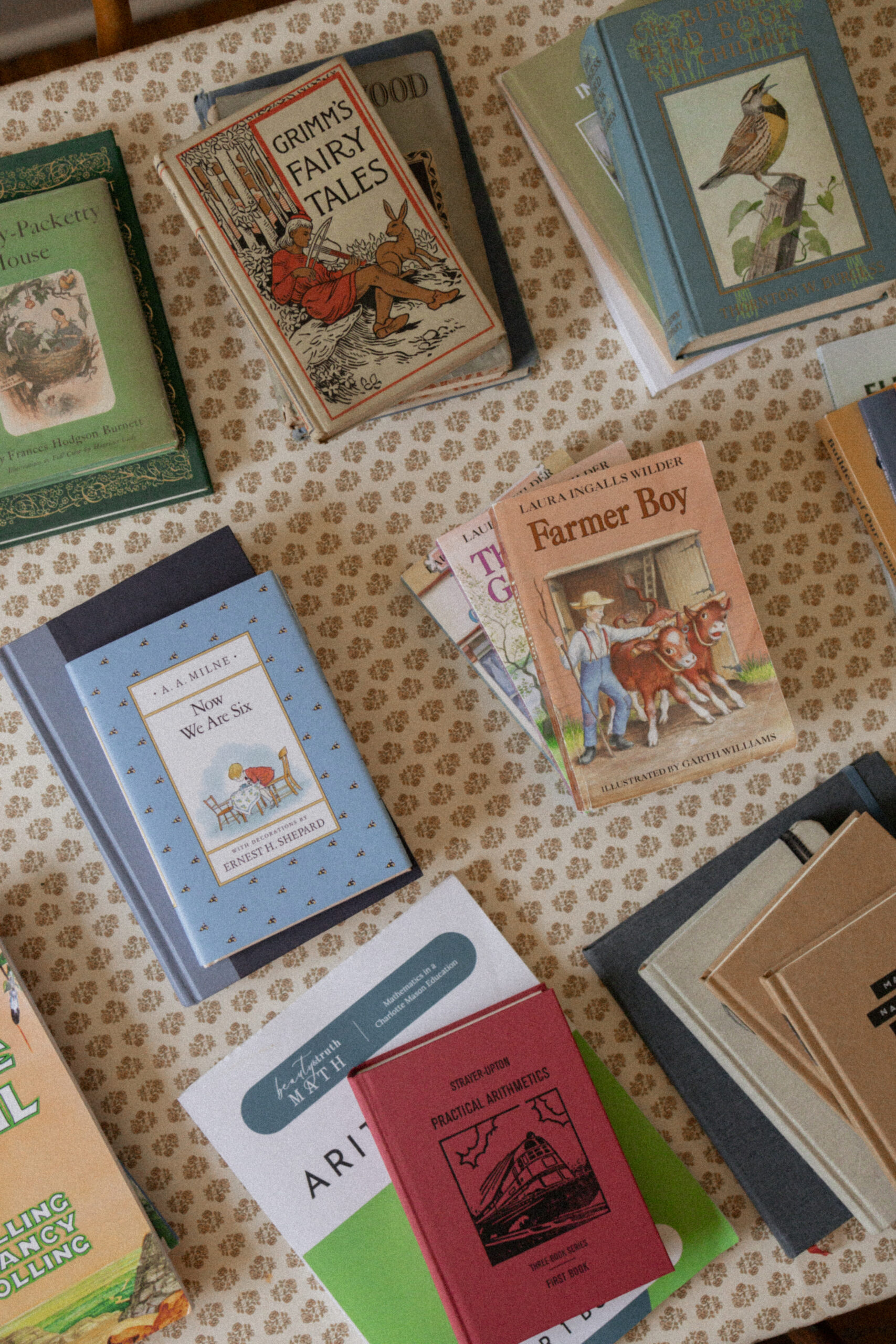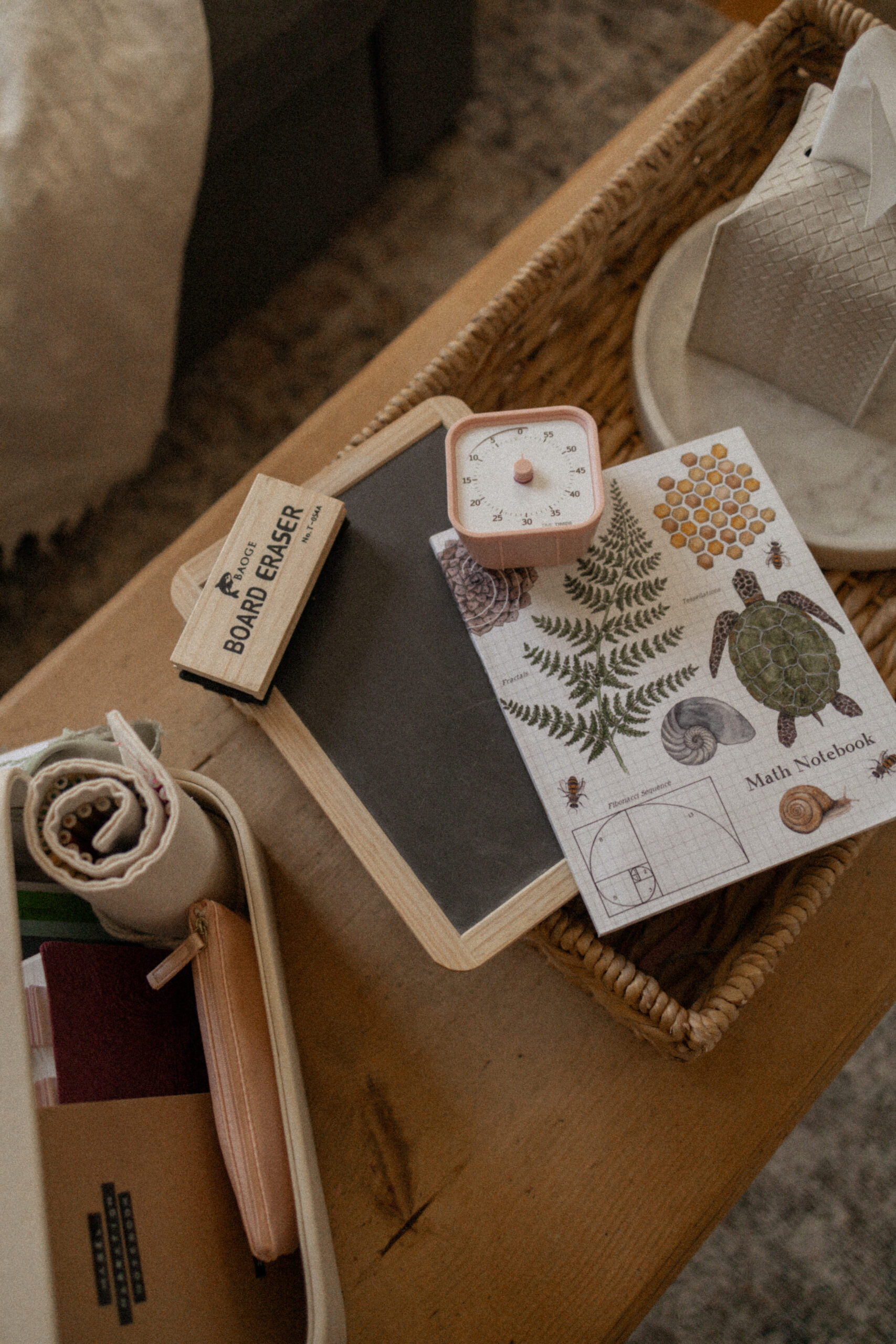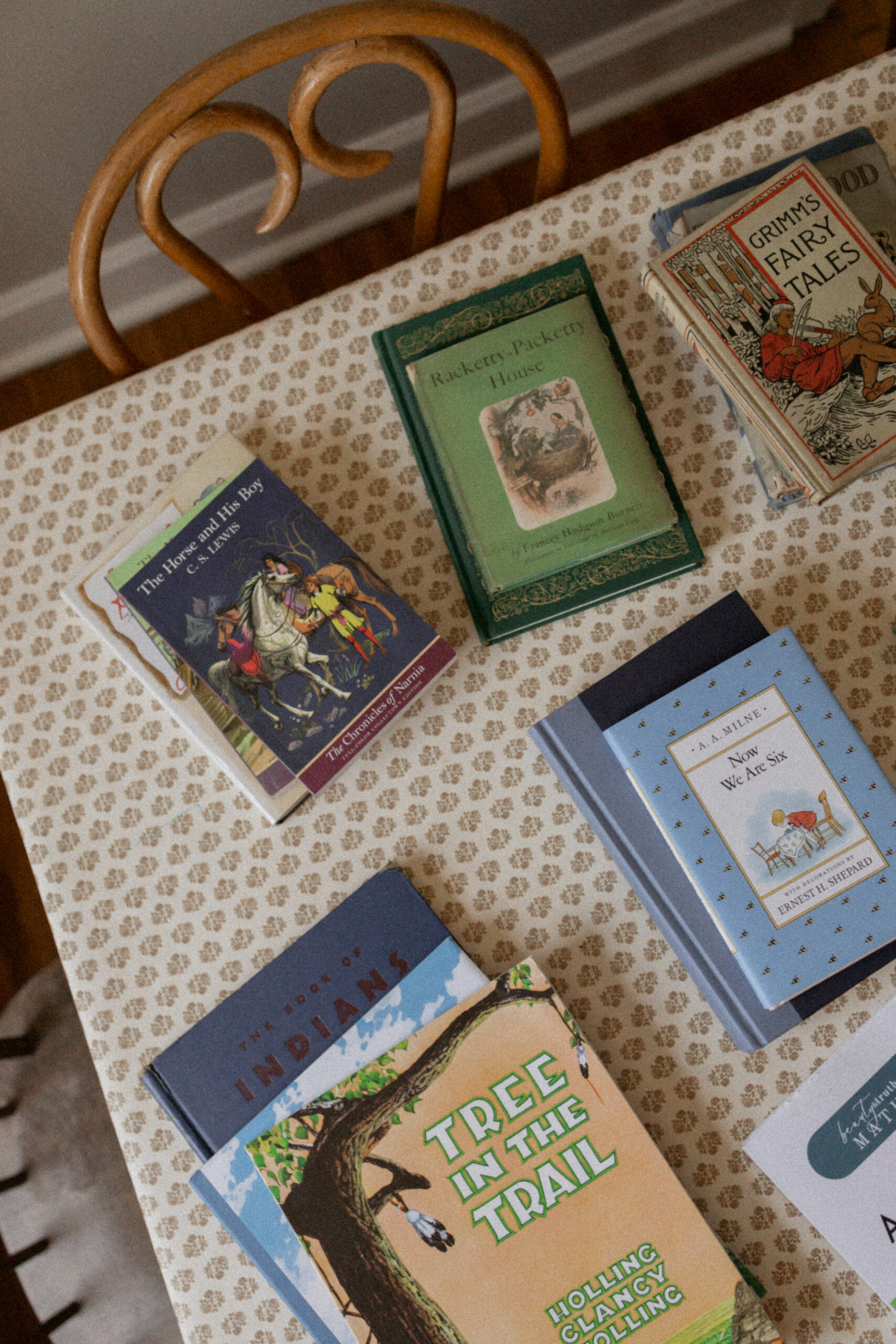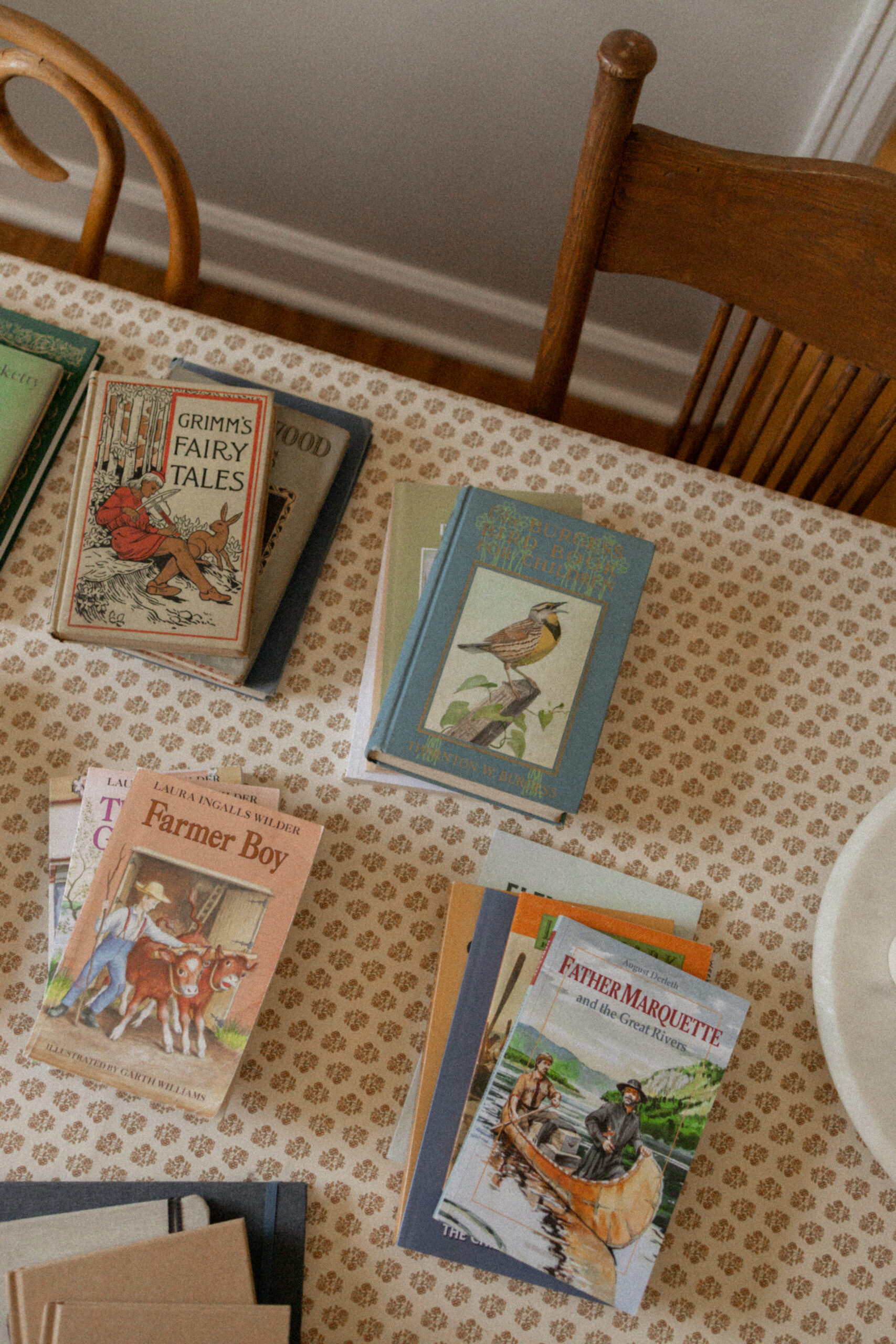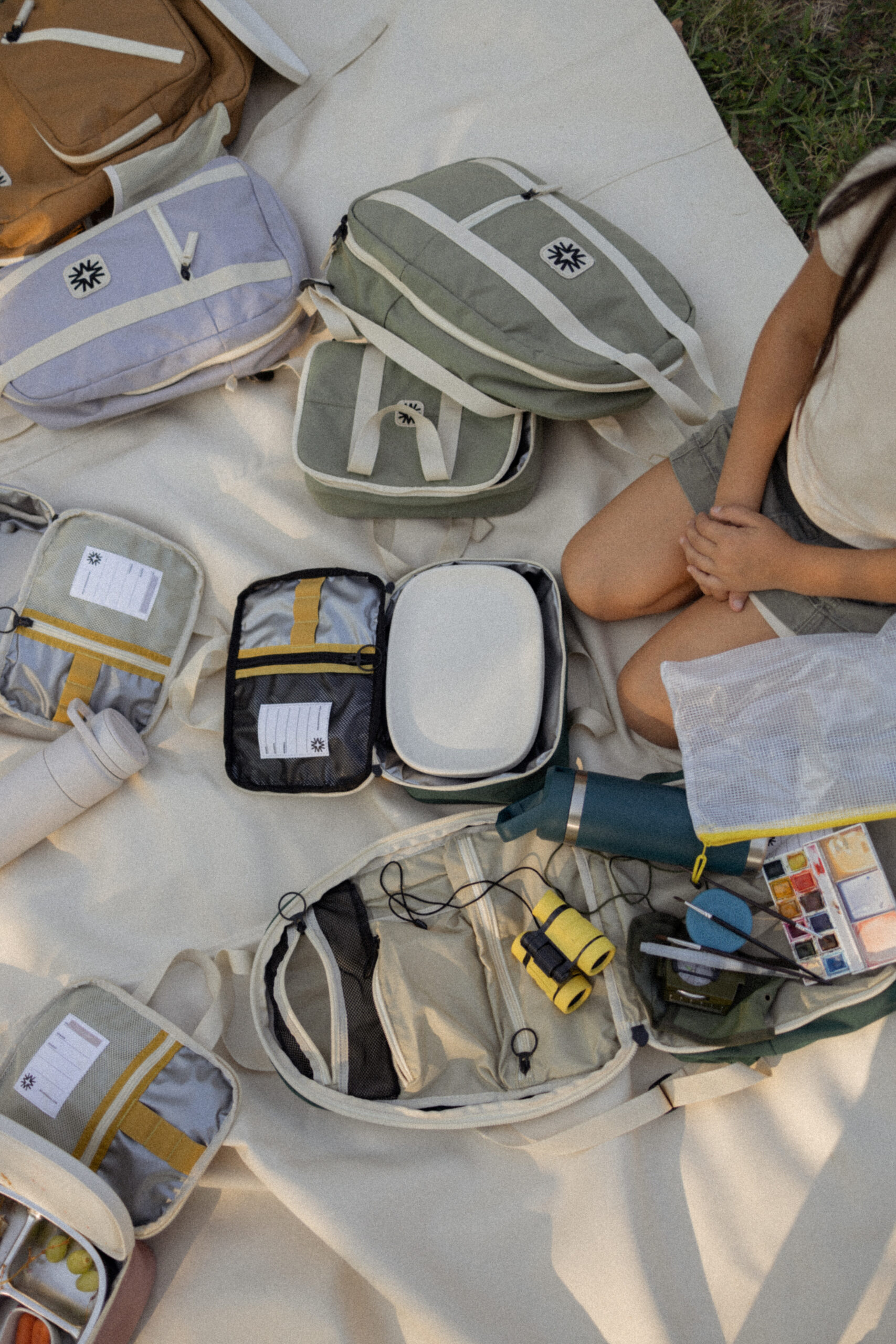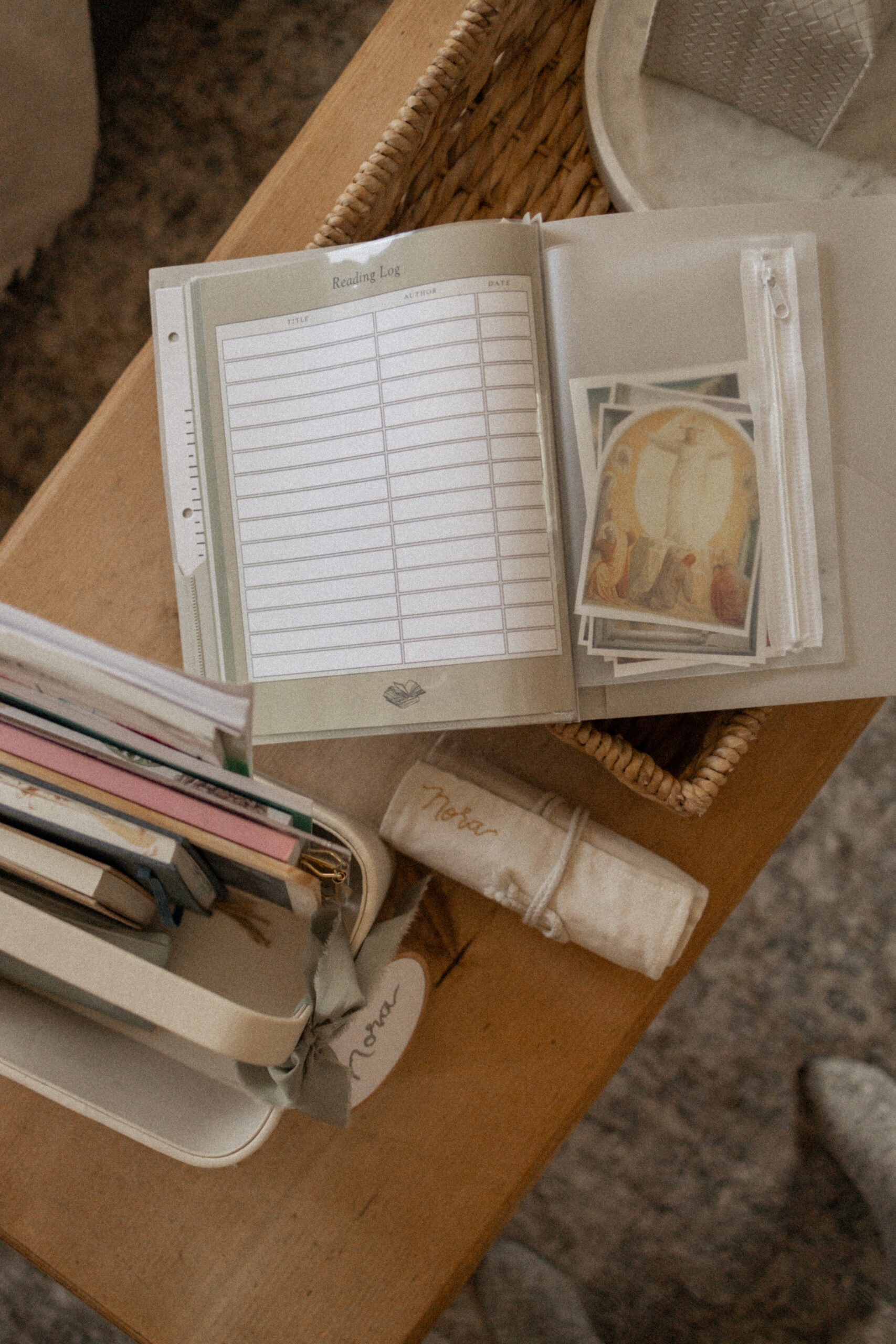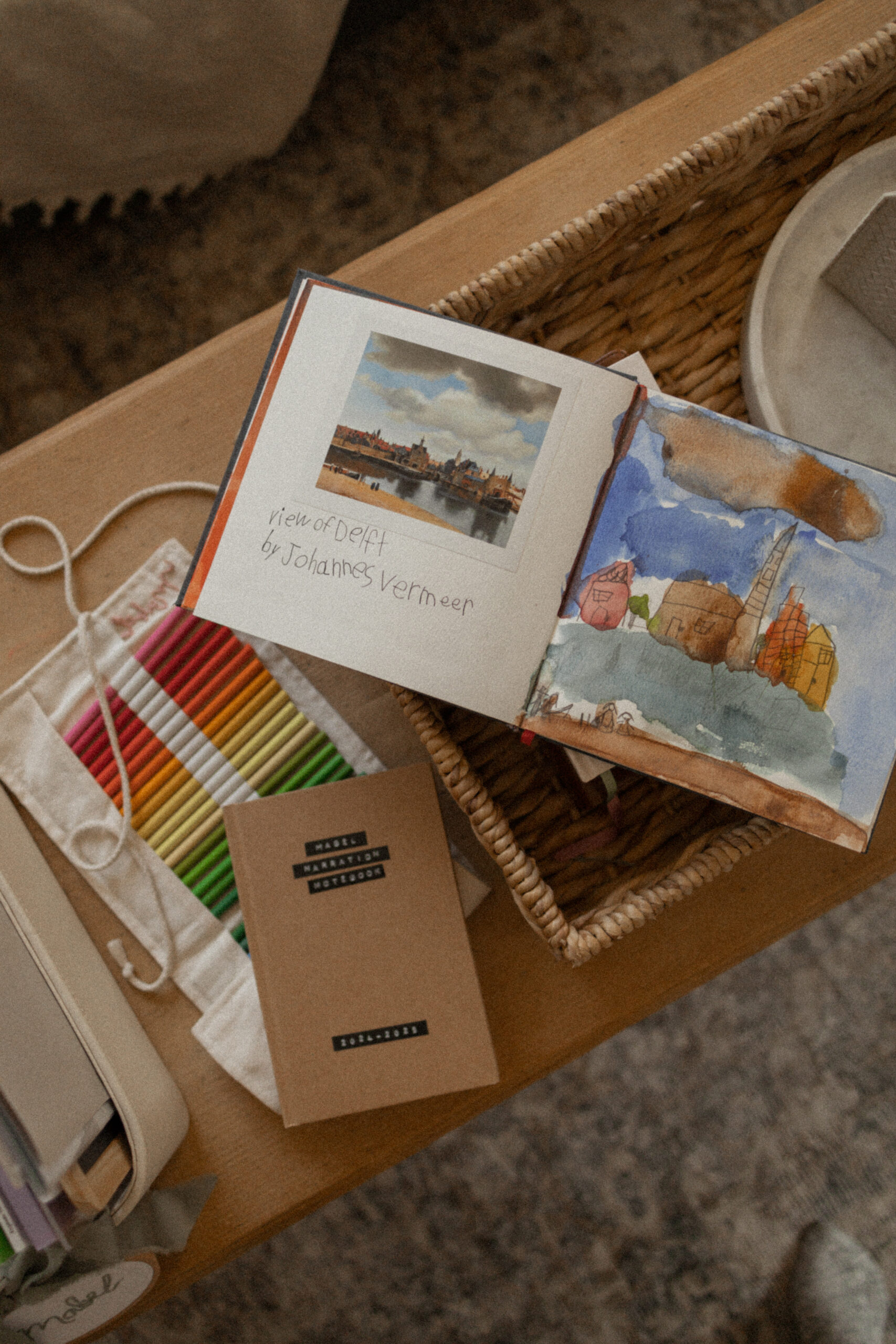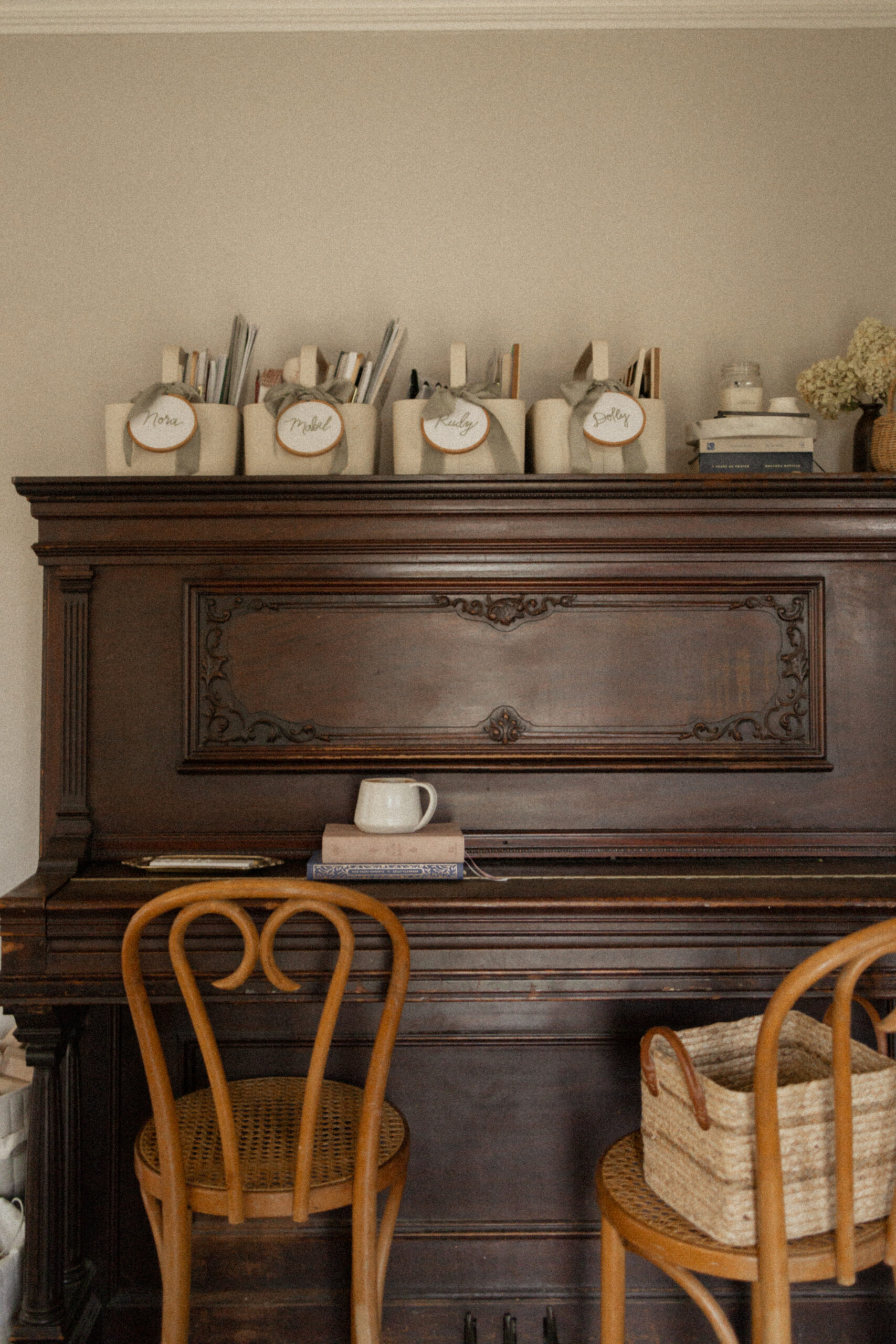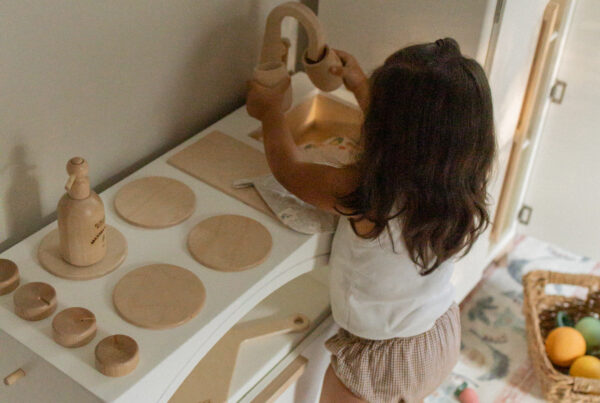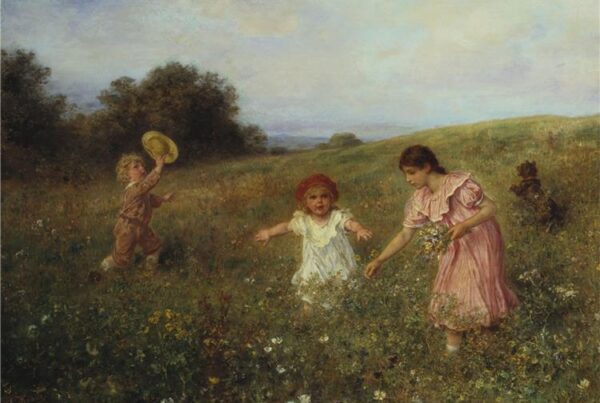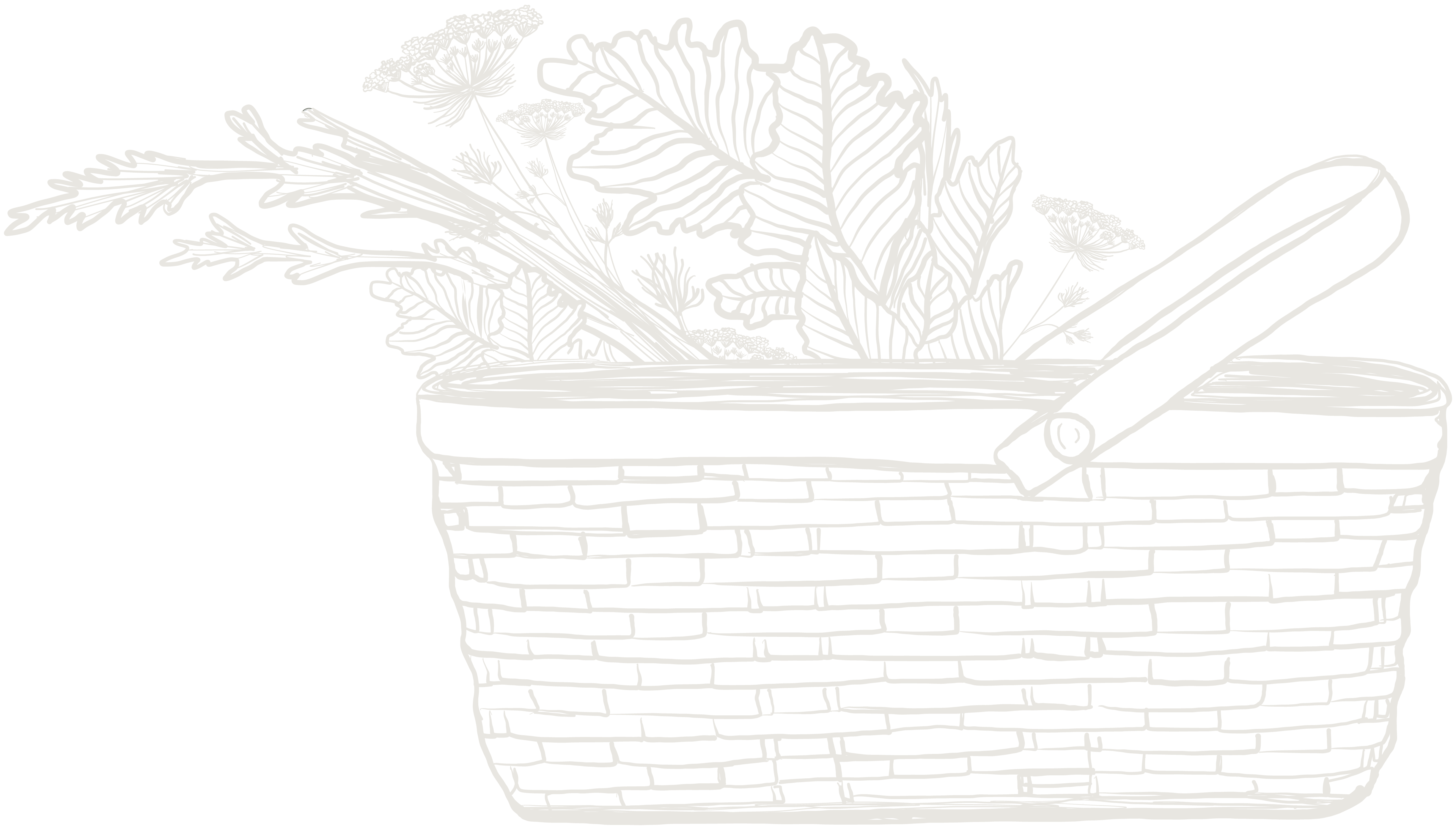HOMESCHOOL CURRICULUM PLANS
Our Homeschool History
We’ve been homeschooling since 2020, but only “officially” since 2022, when my oldest (Nora) turned 6. Our first few years we used (and loved!) The Peaceful Press. We loosely went through (and I really mean loosely) The Peaceful Preschool, and a little bit of Nourishing Nature, and then we did the full year of Playful Pioneers for her first grade year. Mabel is only 16 months younger than Nora and the two of them are two peas in a pod, so she had a very enriching year as well, and would have been considered her “kindergarten” year.
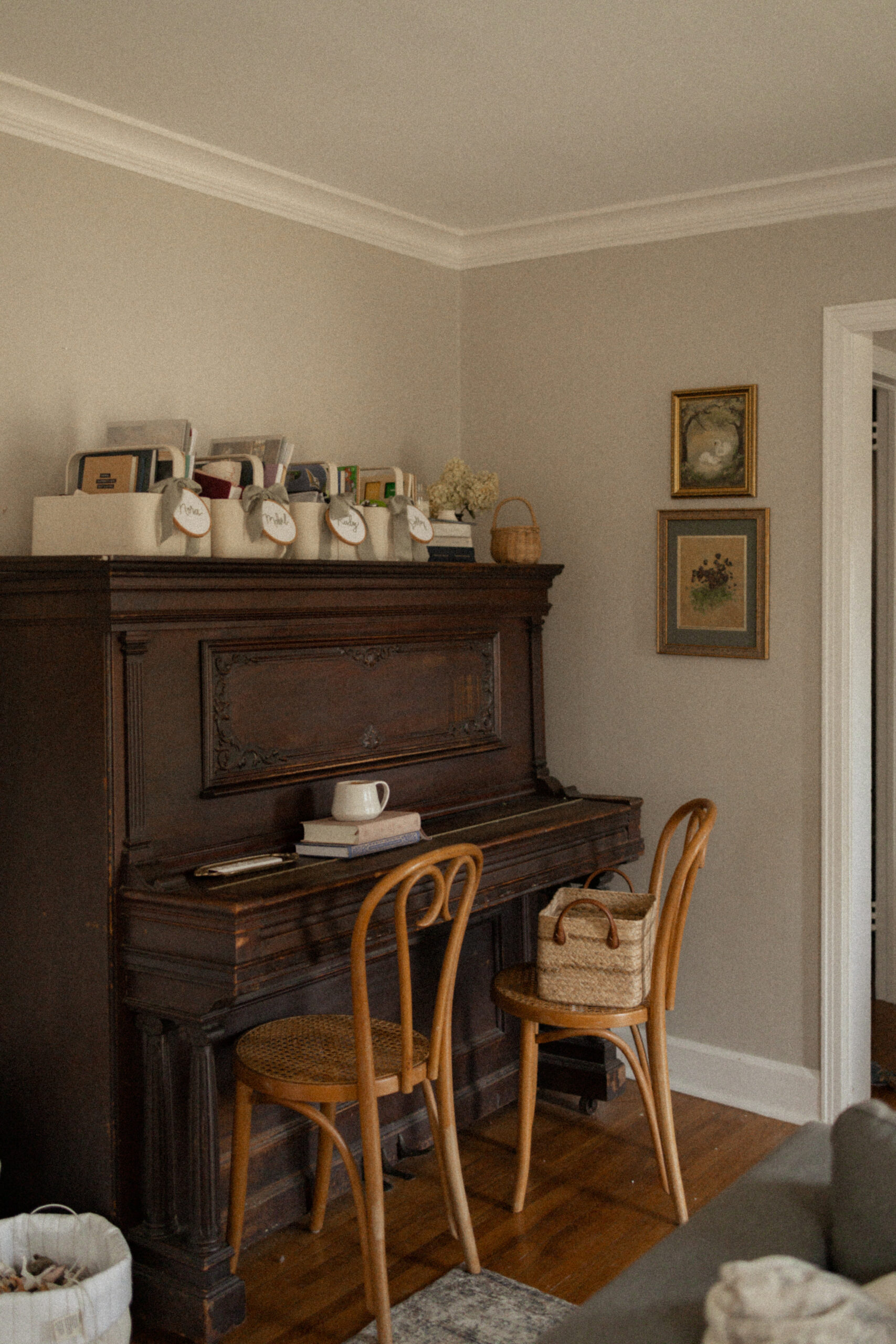
About the CMEC
Last year, we joined The CMEC which is the Charlotte Mason Educational Center. It’s an all-encompassing spine curriculum, that is based off a pure Charlotte Mason philosophy, not just inspired by. It is a program that offers a robust feast for the entire family, keeping the soul and personhood of each individual child at the forefront. They provide the book lists and guides for every subject, every grade level, and other supplies lists as well.
They also have their Mother’s Education course, which is included in the program where the founders host virtual meetings monthly, that you can either sit-in live on, or watch the replays for later. They also include guides and resources for TONS of other common subjects like handicrafts, practical life skills, singing, games, hymns, folksongs, artist study, composer study, and more. It’s truly amazing!
It is a one-time yearly fee of $300 for the entire family. So if you have 3 kids you’re homeschooling, you’d pay that fee one time for the whole family for the whole year, and then would purchase books and supplies separately.
One of the things that attracted me to the CMEC was that the whole family is on the same history cycle at the same time, meaning, I don’t have a 6th grader in Ancient Egypt while my 2nd grader is in American, and my 1st grader is in English… they’re all on the same cycle meaning there can be as much overlap as possible which makes doing family-style lessons so much more doable. Our novels are all read together (aside from what they read independently), our nature/science is all together (would of course separate later down the road when they’re doing more hands-on work), and there are many common subjects we can do all together.
The founders both have a lot of children (one has 11, and has graduated multiple from her home, and are now in college), and are well-versed in home educating multiple children of different ages, stages, and skills at different times. They’ve worked so beautifully to craft a program that is true to Charlotte Mason’s ways, while keeping the family-style learning a priority, and also cultivating autonomy for each child and their own personal growth and interests.
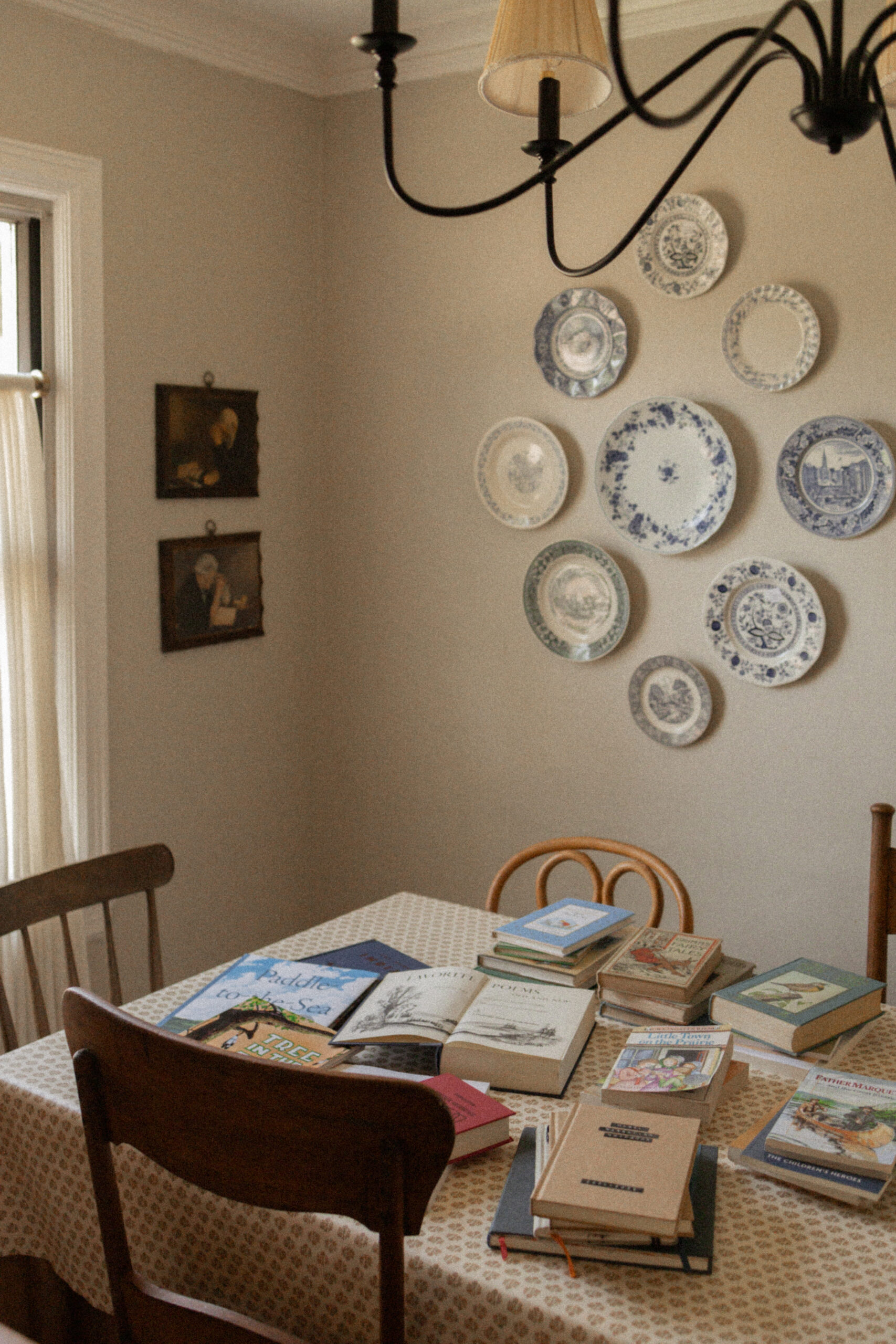
How The CMEC Works
The way the program works is you download the guides (they’re pdfs with written text), watch their live/replay videos of them explaining all the choices made for each subject for the year, and watch their other videos for tips and tricks to make the school year a success, and then you take the guides and form your own timetable and term breakdown based on the information and helpful tips provided. This is the part that I found most overwhelming initially, but doing this is what makes the year flow SO smoothly, and ultimately makes it an “open and go” way of learning. By doing the brunt work upfront (through the Summer), I set myself up for success (even in the February blues) for the whole year.
They don’t make the plans for you, because they know that every single family is different. You’ll want to swap books, you’ll want to combine subjects, you’ll want to separate things into different ways, and so you have full freedom and flexibility to set your year up exactly as you need. Again, at first this aspect was really daunting an overwhelming (especially coming from the Peaceful Press which has the weekly grid, and literally everything already chosen and laid out for you), but now that I’ve done the Summer prep twice, I can honestly say it’s totally worth it.
I will say, if you can find someone local to you to link arms with, that will make it ALL the more enjoyable and fruitful. You’ll get the most out of the program if you’ve got support, I think! Obviously, the same could be true for any curriculum, but there’s so much beauty in this entire program that I really feel the most benefits doing it alongside some of my closest friends, and our kids doing the same “school” at home, too.
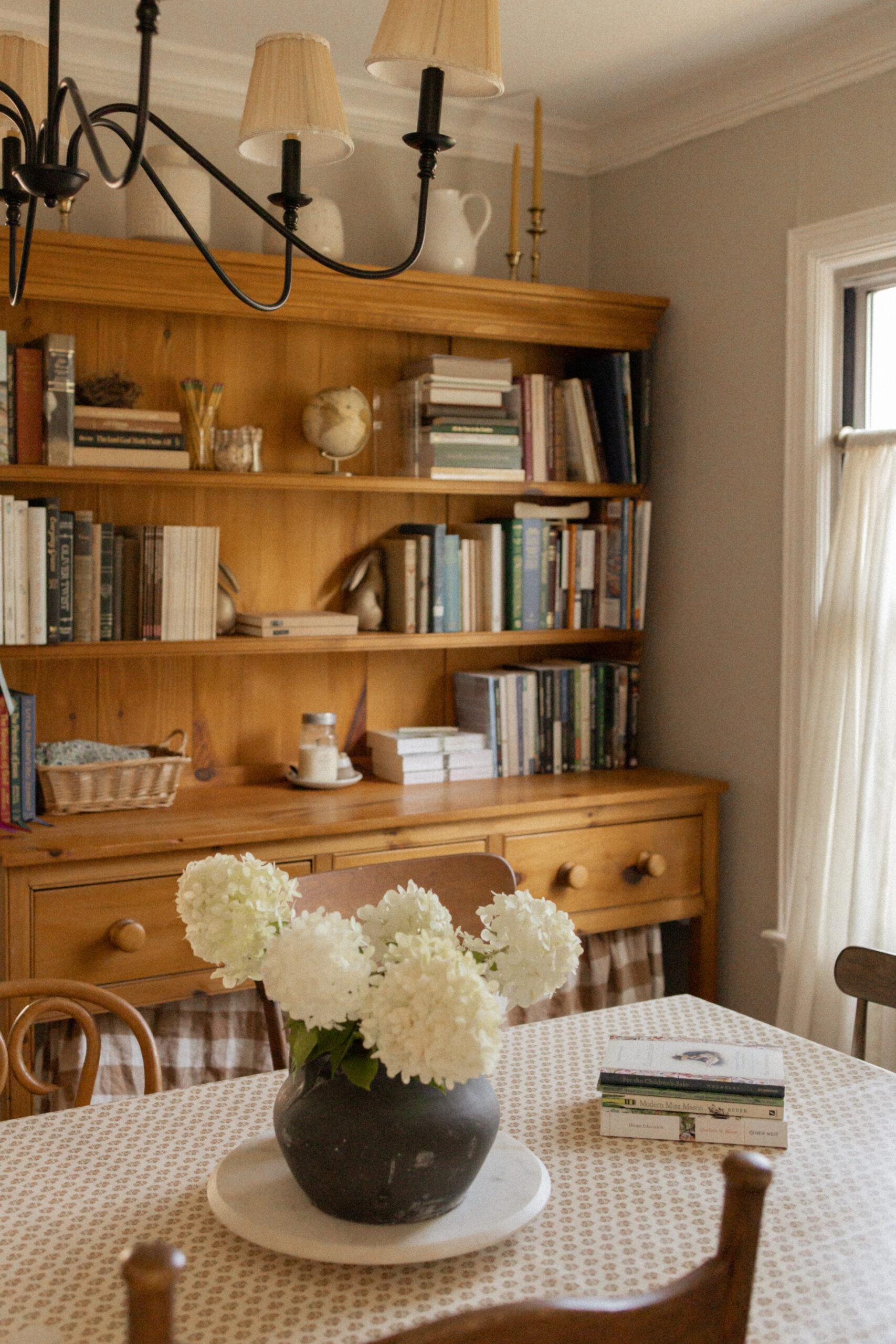
Our Homeschool Curriculum Plans
With all of that said — We’re following the CMEC’s main subject choices, with some additions, and some swaps. I do also want to preface by saying this is not all done in one day. Each subject is truly only 15 minutes long (give or take a few), and some of the books we are only reading once a week. So if looking at this list has your eyeballs coming out of your head, rest assured, I’m a normal mom with a lot on my plate! Our school day (lessons) generally only lasts until 11:30, with some everyday learning and life skills and reading sprinkled all throughout our days. I do have littles! So obviously sometimes we have to veer and pivot, but having a plan is helpful so we know when/where/how to get back on track.
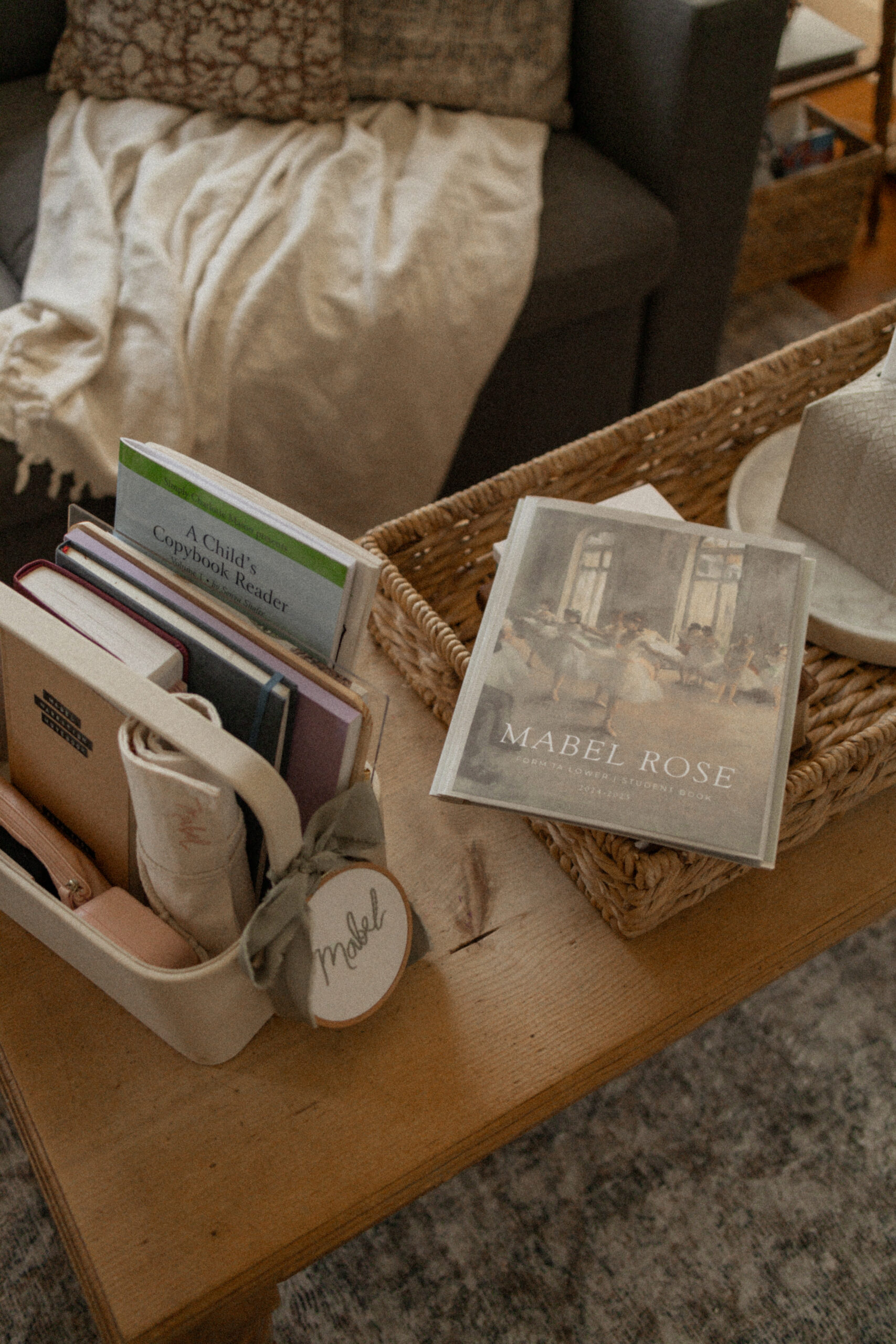
Bible:
We are doing BSF (Bible Study Fellowship) this year (for the first time!), and so we are not following their Bible lesson choices. We are instead going full throttle with BSF’s plans for me and the kids. I also put together my own Morning Time plans just based on books that me or the kids are interested in, and sometimes that includes choices (like hymns or term novels) from the CMEC, but mostly it’s just what I choose on my own.
Morning Time:
I keep a basket dedicated to our Morning Time reads and things on the shelf on the side table by our couch. I sit in that corner by the window and the kids will often play with magnatiles or draw, or sometimes the big girls will take turns doing the reading. The littles are either crawling all over me or playing quietly, or snacking.
- Every Moment Holy (we simply choose something relevant, and one of us reads the prayer aloud)
- New City Catechism (we read the booklet, but then the kids love listening to the coordinating songs on Spotify too, especially in the car)
- Hymn (we are using some of the suggested CMEC hymns, just not the exact versions they recommend) – we learn hymns by learning a stanza at a time
- Scripture Memory (a verse a day is what we focus on, sometimes we stick with one verse for several days)
- All Year in the Garden (daily nature poems for each day of the year)
- Novel (read aloud – usually about one chapter)
History:
We are following the CMEC’s book choices for history! We are still in our American History cycle and loving it. I feel like I’m re-learning everything right alongside my children. We read a lot of narrative-like, story-form, biographies that make us really feel like we’re getting to know the person of history we’re learning about. It helps give a fully well-rounded view of history in that timeframe. We read a chapter or so per book (they’re living books, not textbooks – interesting, captivating, really makes you feel depth with the historical context) per week. We have 3 books we’re reading from, so tackling history 3x a week.
Literature:
- Poetry – We read a poem a day during Morning Time, and additionally during lunch or other downtimes. They’ll often use this for their copywork notebook, or sometimes will write it in their TBG (truth, beauty, goodness) Journal which has watercolor paper, and they’ll paint around it according to the poem. We’re reading from several lovely poetry books this year! Some we’re starting new, some we began last year.
- Novels (we’re finishing our Little House series for Term 1 (we left off at the Long Winter a couple years ago and we needed a pause after that one, lol), and will move onto Frances Hodgson Burnett in Term 2, and C.S. Lewis for Term 3). I’m very excited about our novel choices this year!
- Fairy Tales – We only just started really reading true fairy tales last year and all my kids have actually really enjoyed them. They’re able to figure out when things are morally wrong, or when lessons are learned, without much/any encouragement to get there. It’s been neat to watch their minds work with these tales. We’re reading from a few different books this year… Tanglewood, Anderson, and the Blue Fairy Book. We also have Grimm’s but I’m not sure if we’ll get to that one this year or not.
- Aesop’s Fables – short little moral stories. the kids love these and enjoy finding the meaning behind the fables.
- All our literature choices are from the CMEC guides.
Math:
We have purchased Beauty & Truth Math, and it seems very lovely! I don’t have experience with it quite yet. I will say, I’m a bit overwhelmed at how much prep work is involved. The amount of sheets printed in addition to the actual guides has my head spinning a bit and I’m still wrapping my mind around how I’ll tackle this, so this one is subject to change if it’s not simple and streamlined for us this year. I love how it is formulated, I’m just not super convinced it will be sustainable for us in this current season. I could be wrong, but we’ll see!
Geography:
We are following the CMEC’s guides for geography! We use kinetic sand in a tray to build things like an isthmus or peninsulas or mountain ranges and dunes. We also learn through stories of children in other countries, by the child in the story narrating a day-in-the-life, explaining their surroundings, and different climates. We also read from Holling books. Each lesson, just a chapter at a time (from 3 books, just like history), spread out throughout the year. After each reading is a tangible application like observing and identifying our own surroundings, learning how to read maps, or draw maps of familiar places for the children. I really appreciate the practical approach alongside the abstract for my children who haven’t traveled overseas.
Natural History:
CMEC provides the most precious book choices for Natural History. I was initially intimidated by the name of the subject, but really it’s become one of our favorite reads! We read through Burgess and Buckley stories, which are really sweet and helps us appreciate nature and animals in a new way by getting invested in stories of God’s creation.
Common Subjects:
We are following the CMEC picks for our common subjects, most of which we are utilizing for our co-op, which is one morning each week. They provide which artists, which pictures to study, composers, and even songs to listen to for these. They also have resources for foreign language (Spanish or French — not the curriculum itself, but they have suggestions for both plus curated playlists for songs for both languages). Most of these are once-a-week lessons, but some can simply be woven in whenever, like during afternoon quiet times, etc. These don’t necessarily need to take up morning lesson times.
- Artist Study (co-op)
- Composer Study (co-op)
- Solfege/Solfa (at home via CMEC recommended videos for now, may join local choir class in January)
- Singing Games (co-op/home)
- Recitation (home/co-op)
- Nature Study (co-op/home)
Language Arts/Reading:
Both of my girls know how to read (we used 100 Easy Lessons, but never even got to 100 for either of them), but we are going through the Explode the Code series (have been doing so, slowly over the last couple years) and we’ve been pleased with them. Although we primarily only use books read aloud and notebooking for our lessons, these have been helpful from the beginning so I am content with keeping them for now.
Lots of books! My girls have their own bookshelf in their room full of chapter books they’ve read/are reading/will read/have re-read and it continues to grow. They read their little siblings picture books throughout the day, and take pride in reading letter they receive from friends in the mail. We have lots of reading practice all day long!
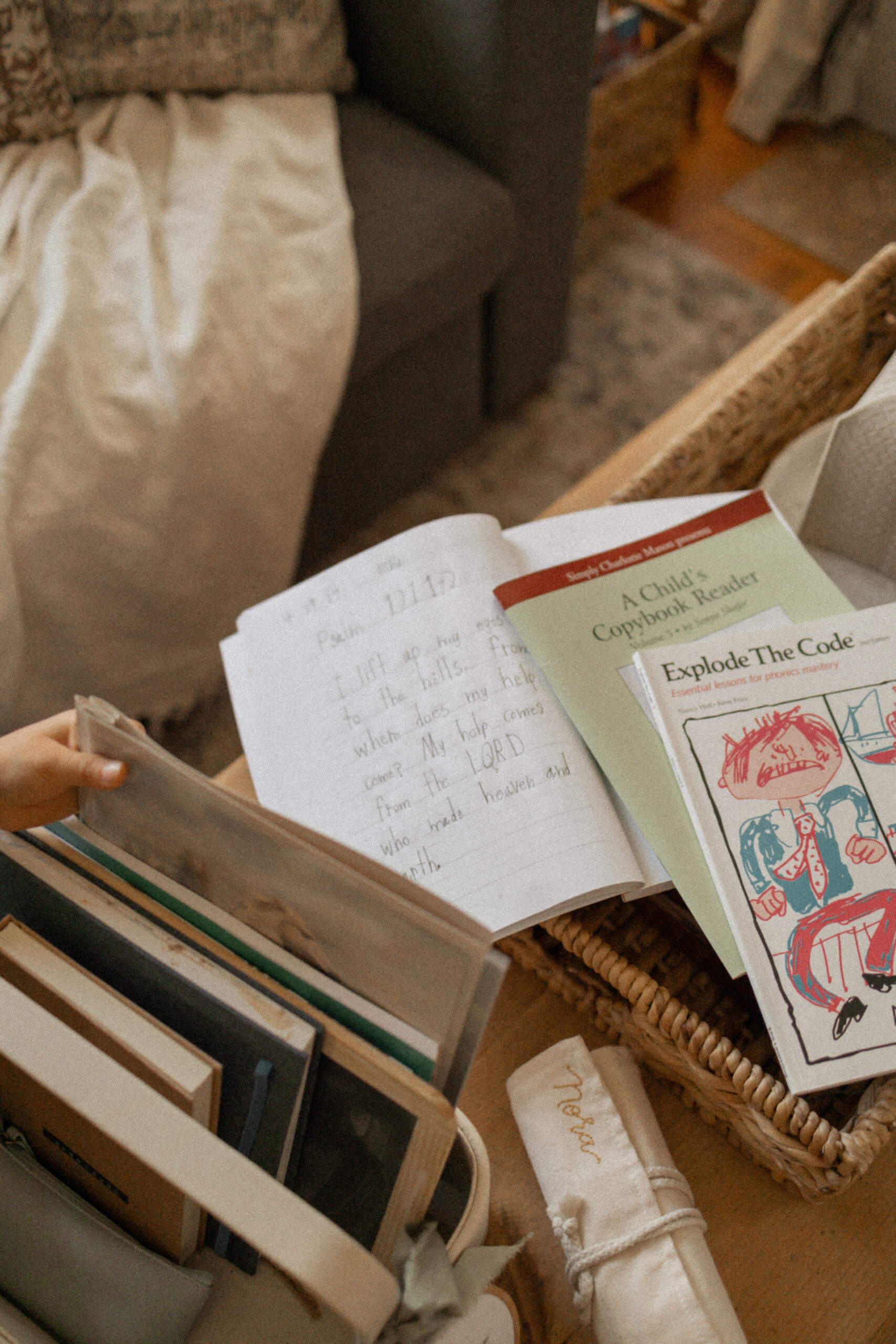
Writing:
My girls are not quite at the grammar stage, however, they are learning so much simply by reading lots and through copywork. They have multiple writing tools right now. They both keep a notebook they write their own personal stories and pretend-lists and things in, which I love for them. They are so creative and it’s always so fun when they come running down the stairs to read a new story one of them has written. Nora has written a book with 14 chapters and has begun recording the audio and she has me send it to my friends so they can play it for their kids, haha. This stage is SO fun!!!!
We have the Simply Charlotte Mason copybook readers which are just so precious and makes it simple and straightforward. We’ve also done Handwriting Without Tears. I just started them at the first level and continued to move up as they finished each one. I don’t rush through these. They’re not busy-workbooks. They’re for handwriting, so I encourage slow, steady, and neat work, over rushed just to finish a notebook.
Notebooks:
We use a Narration Notebook all year long for nearly all subjects. If you’re not familiar with narration, take a look at this book! We’re actually reading through this book with our co-op moms this term, so feel free to join us 🙂 When we read our chapter from the history (or any) book, the children then either tell me back in their words what I read, or, they draw it out and then share with me what they drew and narrate back to me more about the chapter. This goes for any subject. Narration is the assimilation of information. We all narrate all the time, however, it’s certainly using and strengthening a part of the brain that many of us struggle to really utilize these days. Their narration notebooks end up being an heirloom keepsake of what they learned for the school year, and I absolutely love it. As they get older, they begin written narrations over only drawn or oral.
Our TBG Notebook is home for artist/picture study (we like to paste in a small version of our art print for that week on the left side, and then they draw/paint in their “copy” of the piece on the other side. We also use this for poetry at times if they want to add in watercolor or art alongside it. Sometimes they’ve also done the same with a line from a hymn. Often, those are for their copywork notebook, but sometimes something sparks a little extra inspiration so it goes in here. This is an ongoing notebook, and is not solely for one school year (unless it’s full within one). It’s simply a keepsake that we will fill until full.
We use our Nature Journal for nature walks or nature study! Sometimes it’s more formal like a planned hike where we know we’ll come across something lovely to study, other times we find an incredible moth in our garden that we temporarily capture so we can study it and draw it out, and then watch with wonder as we release it back into the wild. Other times we find a special tree and we visit it seasonally to draw or paint it as it changes. And still more times, we see something so beautiful we can’t help but want to remember it, so we add it to our nature journal. This is another keepsake journal that isn’t solely per school year, unless it’s filled up during such.
Copywork Notebook – this is a very simple notebook just for copying a line from a book, a Bible verse, a poem…. anything really. It’s helpful for handwriting, but also for early grammar learning and for remembering.
Caddies:
My children each have their own caddy this year. We have these ones, but you can get get a caddy or basket from any store really. It doesn’t need to be fancy. I do really like how sturdy these are, and that I can easily wipe them down (and I really should wipe down Nora and Mabel’s after a full year of use, haha). I will share Rudy and Dahlia’s in a separate spot geared toward helping little ones while homeschooling older children, but Nora (Form 1A upper/3rd Grade) and Mabel’s (Form 1A lower/2nd Grade) are both pictured throughout this post. Please don’t feel obligated to go and replicate this solely based on it being what I’m doing! I’ve chosen what I have based on knowing my children, finding what does/doesn’t work for us, and want to make sure that this post only serves as a guide to help you find what works best for YOUR children, and not feel like you need to do everything exactly the same way I do.
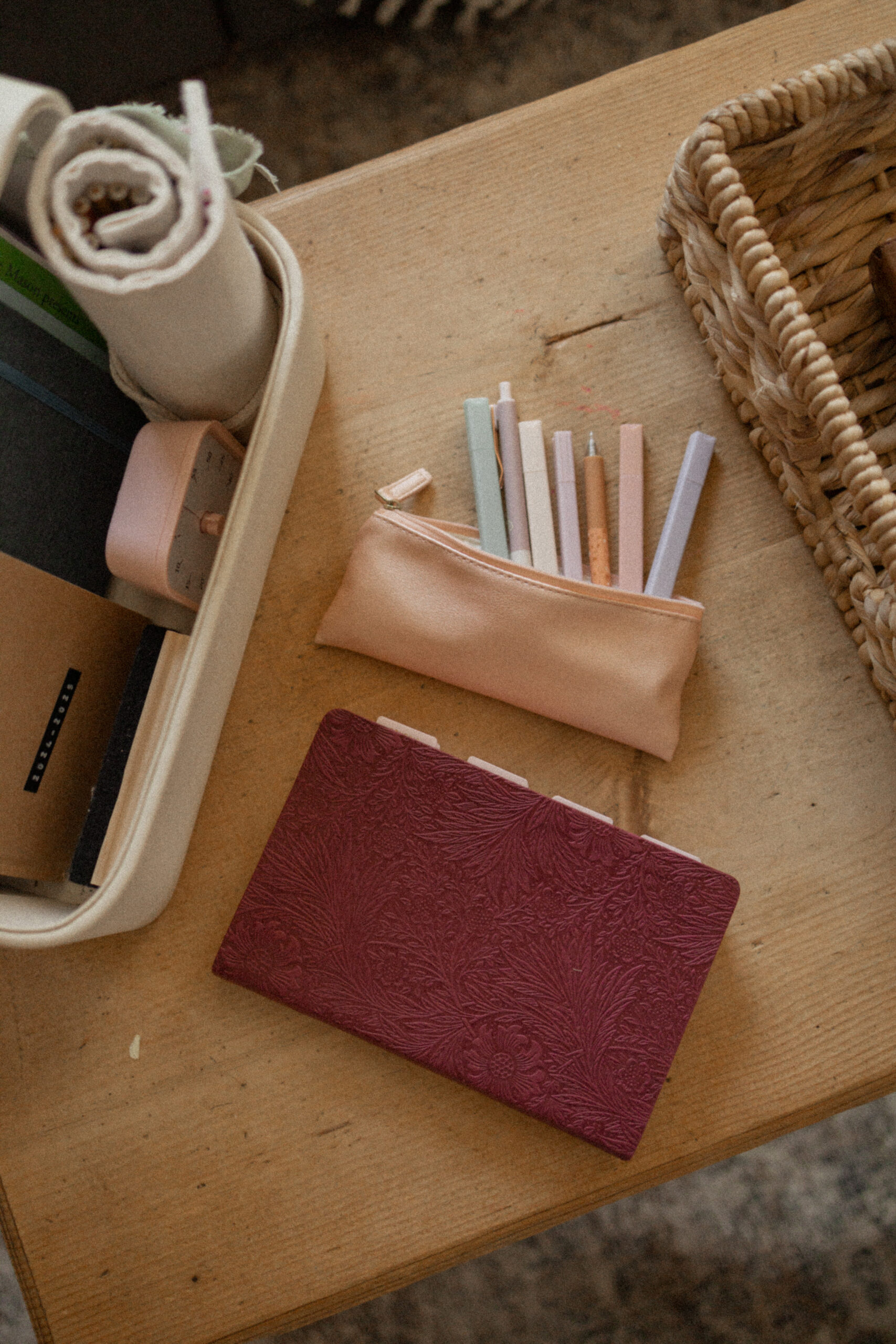
Both girls have their own Bible’s now. Their birthday after they learned how to read, they received their own. It was/is really special! They each have their own pen case with highlighters and pens as well.
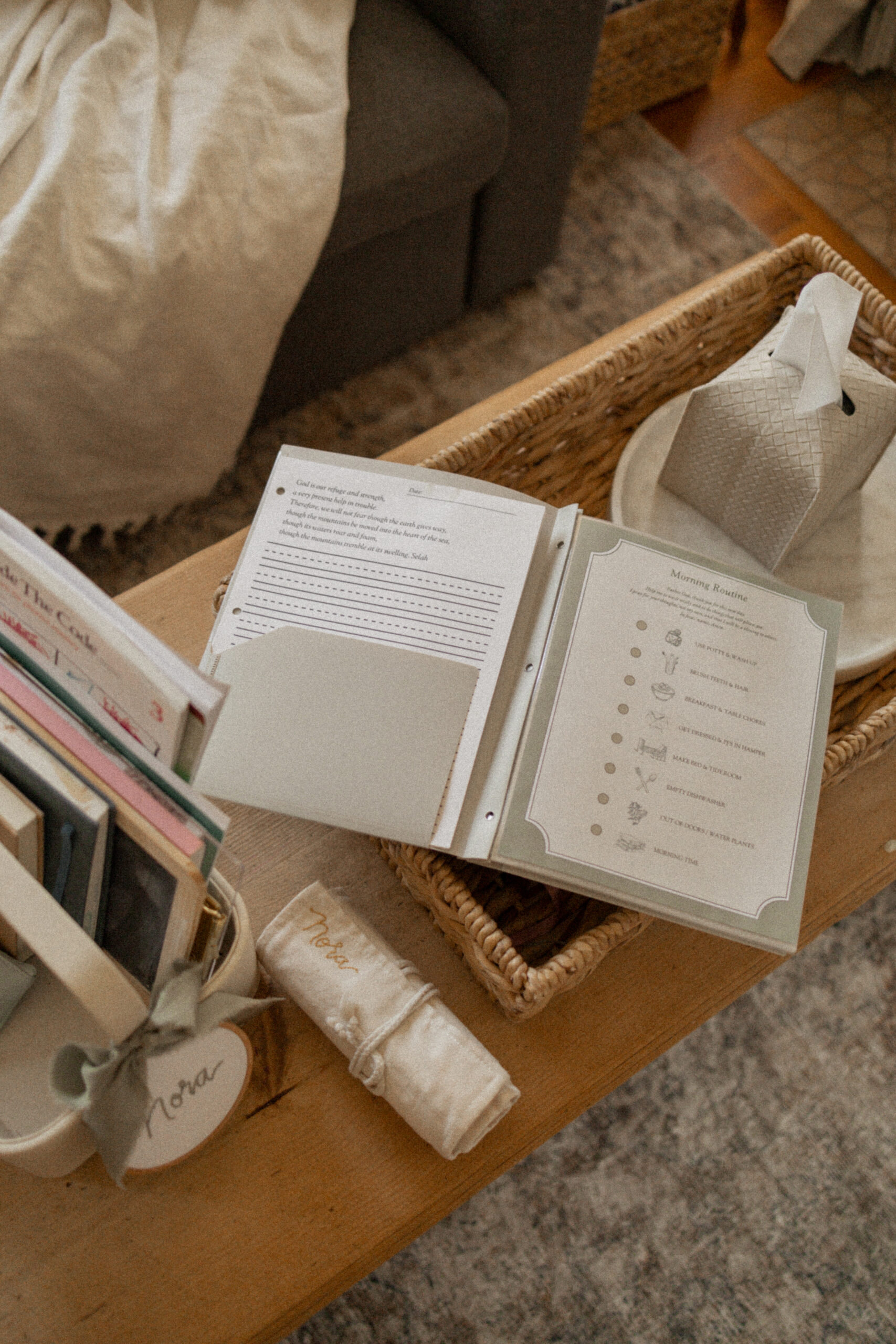
Our Daily Homeschool Rhythm:
We have three days at home this year, and 2 days (in a row) away from home. For the 3 days we are home, this is a basic gist of our rhythm, but remember we have two little ones, plus life can throw curveballs, and schedules are simply a tool, not a master 😉
- 5:30/6 – mother’s morning (my time to read quietly, check my planner, workout, brew tea, etc)
- 7 – children up! morning routine
- 7:15 – breakfast & table chores
- 7:45 – outdoors (unless it’s too cold), water plants, enjoy the morning sun
- 8 – morning chores
- 8:30 – morning time
- 9 – math / handwriting/phonics/copywork (I have them alternate, I will do math with one, while the other does writing work independently, and then they swap)
- 9:30 – tales & literature
- 9:45 – geography
- 10 – history
- 10:15 – snack & observe the birds!
- 10:30 – natural history
- 10:45 – finish chores (& house reset) / free reading
- 11:15 – handicraft (brush drawing, paper sloyd, needlework, etc)
- 12 – lunch, listen to folksongs or worship music & table chores
- 1 – naps/quiet time – outdoors or reading quietly
- 2/3 – handicrafts, art, free play, leisure reading
- 4 – ballet class or blessing hour (which is worship music on while we all work as a team to reset the house, clean up any messes, finish chores, & then we end with a dance party)
- 4:30/5 – prep dinner, kids can listen to Yoto, dance around, play a game, etc
- 5:30 – dinner, thorns and roses, & table chores
- 6 – finish clean up, family walk or family read aloud (or movie night 1x a week)
- 6:30 – kids evening routine / baby in bed
- 7:30 – kids all tucked in, big girls reading
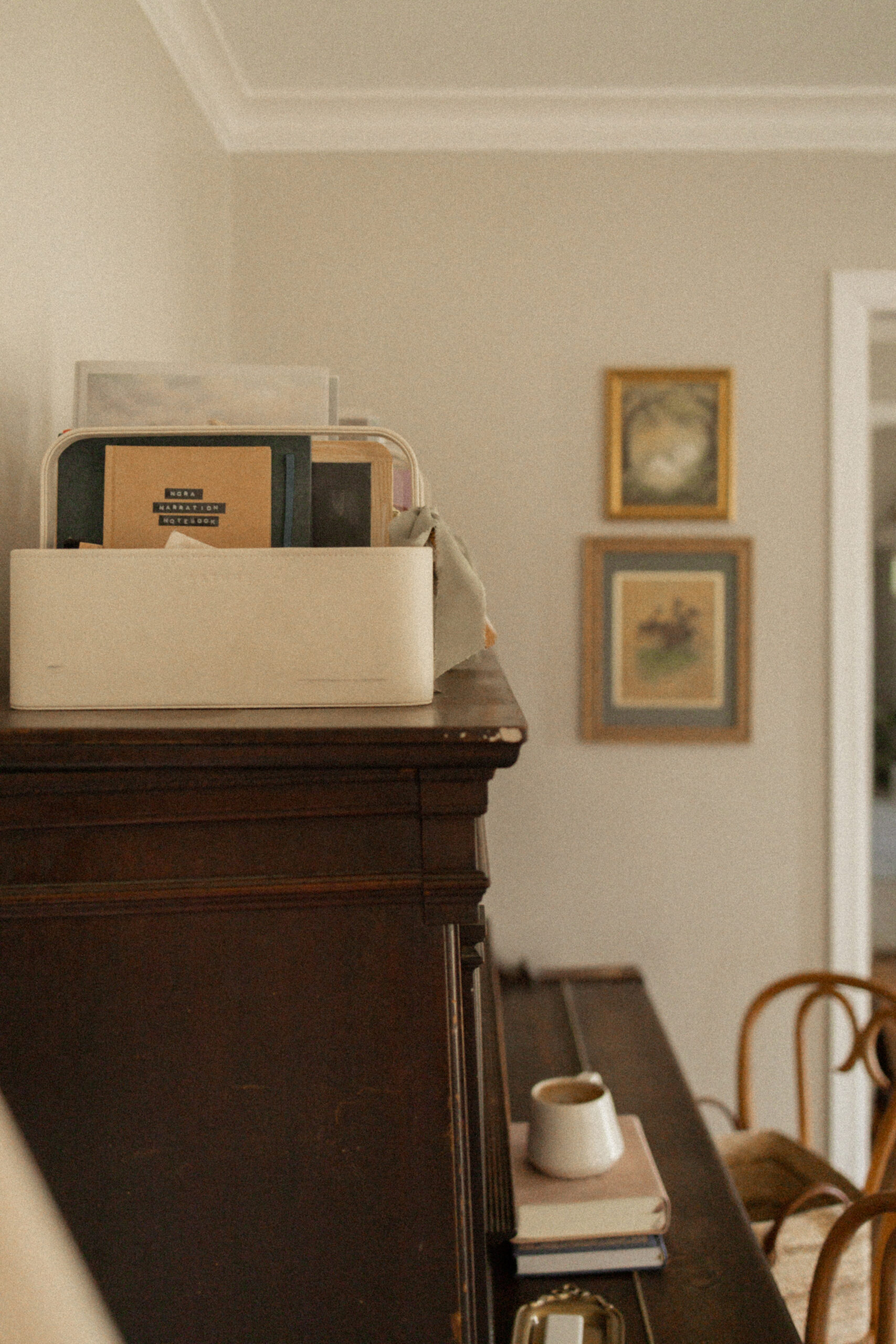
Resources:
I hope this breakdown is helpful! For any of my resources, you can visit my Stan Store or Etsy shop. In my book Making a Home I discuss all things homemaking, creating rhythms and routines, helpful tips for creating a peaceful atmosphere, cultivating a life of intention and connection, keeping up with home tasks as a homeschooling mama, and SO MUCH MORE! Included in my book are printable PDF pages that you can use right away.
Additionally, I created customizable Homemaker Templates for the homemaker which also include mother and child routine pages, house tasks, meal planning, and tons more. Recently, I also released my Mother’s Planner and Student Planner. Both are created as templates in Canva with full customization options to make them uniquely perfect for you! I include full instructions for how and where to print with different price and binding options. You can combine any of these three customizable options to create your perfect, personalized planners for you and your family.
Here are the folios I used to make my girls’ Student Planners, and here are the sheet protectors I used for theirs. I used my Student Planner to customize what my girls needed, but in the download I include so many wonderfully practical and useful pages that I look forward to my children using down the road. Their routine pages are from the Homemaker Templates. You could totally use the folders for a Mother’s Planner as well, and simply omit the sheet protectors and use as a regular planner for several months depending on how many pages you print, for a really cost effective option!
Most of our homeschool supplies can be found HERE! Be sure to also check my highlights on Instagram for more inside looks of the planners from me and others, and links (monthly links, homeschool, planners, making a home).

